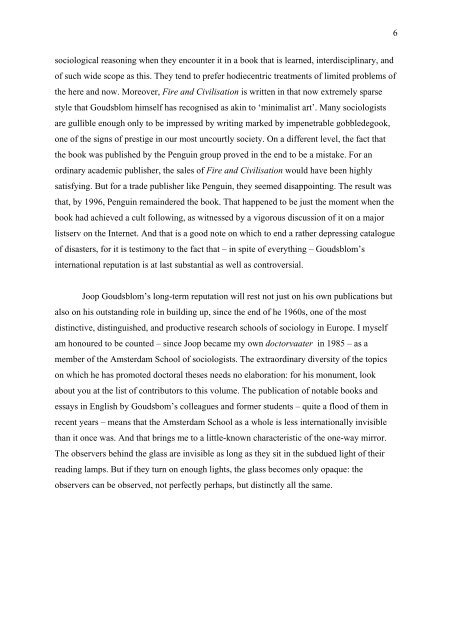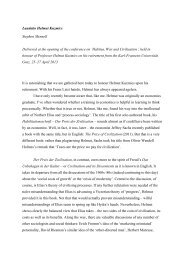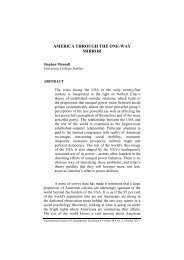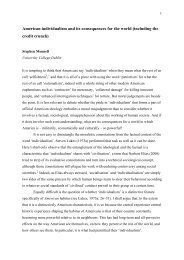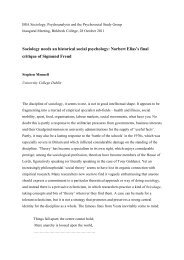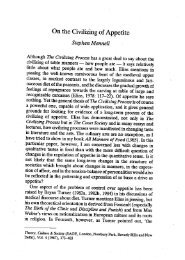Goudsblom behind the one-way mirror - Stephen Mennell
Goudsblom behind the one-way mirror - Stephen Mennell
Goudsblom behind the one-way mirror - Stephen Mennell
Create successful ePaper yourself
Turn your PDF publications into a flip-book with our unique Google optimized e-Paper software.
6sociological reasoning when <strong>the</strong>y encounter it in a book that is learned, interdisciplinary, andof such wide scope as this. They tend to prefer hodiecentric treatments of limited problems of<strong>the</strong> here and now. Moreover, Fire and Civilisation is written in that now extremely sparsestyle that <strong>Goudsblom</strong> himself has recognised as akin to ‘minimalist art’. Many sociologistsare gullible enough only to be impressed by writing marked by impenetrable gobbledegook,<strong>one</strong> of <strong>the</strong> signs of prestige in our most uncourtly society. On a different level, <strong>the</strong> fact that<strong>the</strong> book was published by <strong>the</strong> Penguin group proved in <strong>the</strong> end to be a mistake. For anordinary academic publisher, <strong>the</strong> sales of Fire and Civilisation would have been highlysatisfying. But for a trade publisher like Penguin, <strong>the</strong>y seemed disappointing. The result wasthat, by 1996, Penguin remaindered <strong>the</strong> book. That happened to be just <strong>the</strong> moment when <strong>the</strong>book had achieved a cult following, as witnessed by a vigorous discussion of it on a majorlistserv on <strong>the</strong> Internet. And that is a good note on which to end a ra<strong>the</strong>r depressing catalogueof disasters, for it is testimony to <strong>the</strong> fact that – in spite of everything – <strong>Goudsblom</strong>’sinternational reputation is at last substantial as well as controversial.Joop <strong>Goudsblom</strong>’s long-term reputation will rest not just on his own publications butalso on his outstanding role in building up, since <strong>the</strong> end of he 1960s, <strong>one</strong> of <strong>the</strong> mostdistinctive, distinguished, and productive research schools of sociology in Europe. I myselfam honoured to be counted – since Joop became my own doctorvaater in 1985 – as amember of <strong>the</strong> Amsterdam School of sociologists. The extraordinary diversity of <strong>the</strong> topicson which he has promoted doctoral <strong>the</strong>ses needs no elaboration: for his monument, lookabout you at <strong>the</strong> list of contributors to this volume. The publication of notable books andessays in English by Goudsbom’s colleagues and former students – quite a flood of <strong>the</strong>m inrecent years – means that <strong>the</strong> Amsterdam School as a whole is less internationally invisiblethan it once was. And that brings me to a little-known characteristic of <strong>the</strong> <strong>one</strong>-<strong>way</strong> <strong>mirror</strong>.The observers <strong>behind</strong> <strong>the</strong> glass are invisible as long as <strong>the</strong>y sit in <strong>the</strong> subdued light of <strong>the</strong>irreading lamps. But if <strong>the</strong>y turn on enough lights, <strong>the</strong> glass becomes only opaque: <strong>the</strong>observers can be observed, not perfectly perhaps, but distinctly all <strong>the</strong> same.


